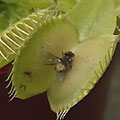Growing Carnivorous Plants
Don visited specialist plant grower and author, David Banks. David demonstrated how easy it is to set up a bog area in a sunny part of your garden, where you can grow a mixed collection of carnivorous plants.
Plants featured in our segment:
Pitcher or trumpet plant (Sarracenia sp. and hybrids)
These hardy plants are native to North America. There are eight species as well as a number of hybrids. Sarracenias catch insects in modified leaves, or pitchers. Some of the pitchers secrete nectar to attract their prey, and they’re often beautifully coloured in shades of purple, green, red or brown. Once an insect falls into the pitcher, it can’t get back out because the waxy sides are too slippery, and inside some pitchers there are downward facing hairs which prevent any escape. There are different kinds of pitchers, for example S. leucophylla is tall with red veins, and S. purpurea is low growing with small rosettes.
Fork sundew (Drosera binata)
This plant is an Australian native. It has hairy, pale green to reddish leaves, which are once or twice forked. It bears large white flowers on erect stems in summer.
There are 54 species of Drosera, or sundew, in Australia. They have extremely sticky hairs on the surface of their leaves, which attract and catch insects. The process of digestion then begins, with some species actually curling the leaf over the insect. The sun sparkles on these little plants in the morning, hence the common name sundew.
Venus fly trap (Dionaea muscipula)
This plant grows in nutrient-poor bogs in its native North America. The hinged leaves have stiff spines along their margins, and glands which secrete insect-attracting nectar. When tiny sensitive hairs inside the leaves are touched twice within about twenty seconds, the mechanism is activated and the leaf closes. The trap then tightens and seals around the victim, and enzymes are released to begin the digestive process, which can take anything up to a week. Although it’s fun to touch the leaves and see them close, don’t do it, because repeated false alarms can cause the traps to die.
David’s growing tips
Grow carnivorous plants in full sun. Carnivorous plants do not need to be fertilised, as they catch their own food. These are bog plants and should never be allowed to dry out. Stand the pots in saucers full of water, or in a shallow pond in the garden. David stands his pots in polystyrene boxes, which float in a pond. Holes in the base of the boxes ensure that the plants are sitting in a constant level of water at all times. Venus fly traps need deep pots as their roots grow down rather than out. Grow them in a mix of about 50% coarse sand to 50% peat moss. Avoid setting off the traps, as it weakens the plants.
Cost and availability
Pitcher or trumpet plants ($10-$30) and Venus fly traps ($5-$15) are available at nurseries and garden centres. Fork sundews cost around $10 from specialist carnivorous or native plant nurseries.
The best time to buy is in spring, summer and early autumn.
Further information
We filmed our story with specialist plant grower and author, David Banks (Email: [email protected]).



